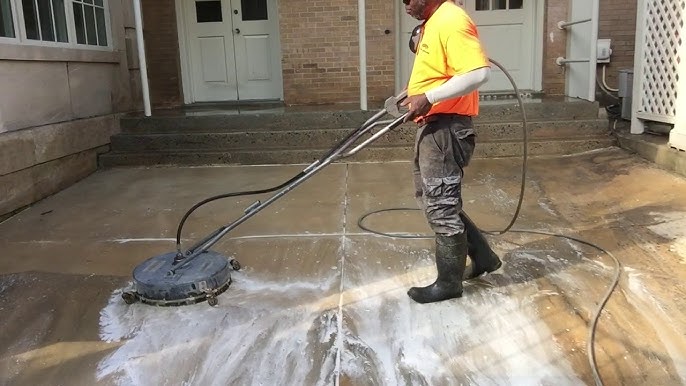
Wildfires can leave behind more than scorched landscapes—they also blanket homes, driveways, fences, decks, and outdoor furniture with fine ash and soot. This residue isn’t just unsightly; it can be hazardous to breathe and corrosive to surfaces over time. 😷
If your property has been affected by wildfire smoke or falling ash, you might be wondering: Can I use a pressure washer to clean it off safely? The answer is yes—but there are important steps and precautions to follow.
In this guide, we’ll walk you through how to properly pressure wash surfaces to remove wildfire ash while minimizing health risks and preventing damage. 🧼🏠
🧠 Why Ash Cleanup Is Crucial
Ash from wildfires is different from typical dust or dirt:
- It contains fine particles that can irritate lungs and skin
- It may carry toxic compounds from burned plastics or chemicals
- It is highly alkaline, which can corrode paint, wood, or metal
- It settles into cracks and textures, making it hard to remove with just a hose
Prompt cleaning not only protects your property but also your health and the surrounding environment. 🌍
⚠️ Safety First: What to Do Before You Begin
Because ash can be hazardous, it’s essential to protect yourself:
- Wear an N95 respirator or better
- Use protective goggles, gloves, long sleeves, and closed-toe shoes
- Keep children, pets, and anyone with asthma indoors during cleaning
- Avoid sweeping or blowing dry ash—it can become airborne
🚫 Never dry-brush ash or use leaf blowers—it stirs up dangerous particles.
🧰 Tools and Supplies You’ll Need
- Pressure washer (2,000–3,000 PSI recommended)
- 25° (green) or 40° (white) spray nozzle
- Garden hose and sprayer
- Eco-friendly detergent or degreaser
- Push broom or stiff outdoor brush
- Plastic sheeting (for sensitive areas)
- Wet/dry shop vac (optional for interior garages)
- Face mask, gloves, and protective clothing
- Water-safe ash disposal bags (if collecting manually)
Browse Amazon Here For Top Rated Power Washers And Accessories
🛠️ Step-by-Step: Pressure Washing Ash Off Exterior Surfaces
1️⃣ Start with a Gentle Pre-Rinse
Before applying pressure:
- Use a garden hose to wet the entire surface
- This helps suppress airborne particles
- Rinse gently to prevent ash from becoming airborne
Focus on horizontal surfaces like:
- Driveways and patios
- Decks and outdoor furniture
- Walkways and stairs
2️⃣ Apply Soap or Cleaner
Use a detergent designed for outdoor surfaces and apply it with:
- A foam cannon attachment
- A low-pressure spray nozzle
- A pump sprayer for detailed areas
Let the detergent dwell for 5–10 minutes to break down soot and ash. Don’t let it dry.
♻️ Use a biodegradable soap to prevent runoff contamination.
3️⃣ Begin Pressure Washing
Now attach your spray tip and begin cleaning:
- Use a 25° or 40° nozzle
- Keep the wand 12–18 inches away from the surface
- Work in small sections from top to bottom
- Use overlapping passes for even results
For textured surfaces like stucco or stamped concrete, use a crosshatch pattern to dislodge ash in grooves and recesses.
4️⃣ Focus on Trouble Areas
Soot and ash cling to:
- Roof eaves
- Window sills
- Door frames
- Vents and screen enclosures
- Deck crevices and railing joints
Use your pressure washer at an angle to get into corners, or finish with a soft brush in detailed spots.
5️⃣ Final Rinse and Air Dry
Once clean:
- Rinse everything thoroughly
- Let surfaces air dry
- Avoid foot traffic until everything is fully dry (ash can be slippery)
🧼 What Surfaces Can Be Safely Cleaned?
| Surface | Safe to Pressure Wash? |
|---|---|
| Concrete | ✅ Yes |
| Vinyl siding | ✅ Yes |
| Stucco | ⚠️ Yes, low pressure only |
| Wood decks | ✅ Yes, low pressure + care |
| Metal fencing | ✅ Yes |
| Roof shingles | ❌ No – use a soft wash method |
🧯 What to Avoid During Ash Cleanup
- ❌ Using bleach (creates toxic runoff)
- ❌ Spraying directly at vents or HVAC intakes
- ❌ Letting ash sit for days—it can etch or stain
- ❌ Using high pressure on soft materials (wood, stucco)
- ❌ Washing ash into storm drains (use landscaping to trap it)
🗑️ What to Do With Collected Ash
If you’re vacuuming or collecting ash manually:
- Double-bag in heavy-duty plastic
- Label it clearly as “ash waste”
- Dispose of it according to local hazardous waste guidelines
🧤 Never dump ash directly into green bins or compost piles.
🔄 How Often Should You Clean After a Wildfire?
Even after the flames are gone, ash can linger for weeks. Follow these cleanup intervals:
| Action | Frequency |
|---|---|
| Rinse decks and patios | Weekly until clear |
| Pressure wash siding | Once after ash settles |
| Clean outdoor furniture | 1–2 times, depending on exposure |
| Rinse windows and sills | Weekly for visibility and protection |
💬 Final Thoughts
Pressure washing is one of the most effective ways to safely remove wildfire ash from exterior surfaces. Just remember: use low to moderate pressure, work in sections, and protect yourself during the process.
A thorough cleanup not only improves the look of your property—it also protects your health and helps your surfaces last longer.
Take your time, wear your gear, and reclaim your clean space one pass at a time. 🔥💦🏡
Browse Amazon Here For Top Rated Power Washers And Accessories



